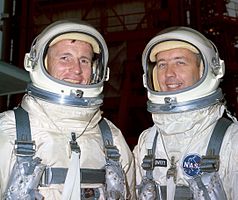Gemini 4
| Mission emblem | |||
|---|---|---|---|

|
|||
| Mission dates | |||
| Mission: | Gemini 4 | ||
| COSPAR-ID : | 1965-043A | ||
| Spacecraft: | Gemini 4 | ||
| Launcher: | Titan II Gemini 62-12559 | ||
| Crew: | 2 | ||
| Begin: | June 3, 1965, 3:16:00 p.m. UTC | ||
| Starting place: | LC-19 , Cape Canaveral | ||
| Landing: | June 7, 1965, 17:12:12 UTC | ||
| Landing place: |
Atlantic Ocean 27 ° 44 ′ N , 74 ° 11 ′ W |
||
| Flight duration: | 4d 1h 56min 12s | ||
| Earth orbits: | 62 | ||
| Recovery ship: | USS Wasp | ||
| Orbit inclination : | 32.53 ° | ||
| Apogee : | 282.1 km | ||
| Perigee : | 162.3 km | ||
| Covered track: | 2,782,486 km | ||
| Team photo | |||
 from left Edward White and James McDivitt in pressure suits |
|||
| ◄ Before / After ► | |||
|
|||
Gemini 4 (GT-4) was a manned space flight under the US Gemini program .
crew
The first manned Gemini flight, Gemini 3 , had not yet started when NASA announced the crew for Gemini 4 on July 27, 1964. The flight was scheduled for the first quarter of 1965.
James McDivitt was nominated as commander and Edward White as pilot . It was noteworthy that both came from the second group of astronauts selected, so they had no space experience. McDivitt had been given preference over the Mercury veterans Walter Schirra and Gordon Cooper .
The substitute team with Frank Borman and Jim Lovell was from the second group.
Astronaut Clifton Williams served as the liaison spokesman ( Capcom ) during the launch phase from Cape Kennedy . Gemini-3 commander Virgil Grissom later took over from the new flight control center in Houston , Texas , now the Lyndon B. Johnson Space Center .
preparation
In contrast to the relatively short flight of Gemini 3, Gemini 4 should take several days. In the course of the flight, an American astronaut was supposed to leave the spacecraft for the first time. A new space suit was necessary for this. A stay of 30 minutes in space was assumed as the basis for development.
During the preparation of the Gemini flight, the Soviet Union got ahead of the Americans. On March 18, 1965, the cosmonaut Alexei Leonow left his spaceship Woschod 2 and was thus the first person to float freely in space .
The Titan rocket for Gemini 4 was set up at the launch pad on March 29, 1965. The spaceship was delivered on April 4th and mounted on the tip of the rocket on April 14th.
Gemini 4 was the first flight to be fully monitored by NASA's new control center in Houston.
Flight history
The launch took place on June 3, 1965 and was broadcast to Europe for the first time on television by satellite.
In Earth orbit , McDivitt tried to use the Gemini spaceship to approach the second stage of the Titan rocket, but it failed. Since the tanks of Gemini 4 were smaller than those of the following spaceships, further approach maneuvers had to be dispensed with.
The planned exit of White had to be postponed by one orbit because the preparations needed more time than planned and White should rest again. When White left the spaceship four and a half hours after take-off, he was connected to it by a safety line, which also had lines for oxygen and radio. White himself could move with a recoil pistol. He enjoyed this excursion and showed no signs of dizziness or disorientation. White stayed outside the spaceship for a total of 23 minutes. Work was not planned for this first spacecraft .
On the fourth day of the flight problems arose with the IBM on-board computer, which ultimately failed completely. The computer should have controlled the attitude during re-entry , so a rotation method had to be used. The target point was missed by about 80 kilometers. McDivitt and White were recovered by helicopter and taken aboard the aircraft carrier USS Wasp . The astronauts were immediately medically examined. They were exhausted, but otherwise in good physical shape.
Edward White during EVA
Importance to the Gemini program
This mission showed that the Gemini spaceship was also suitable for longer flights. With a flight duration of four days and two hours one was still behind the four days and 23 hours that Valeri Bykowski had presented two years earlier in Vostok 5 , but longer flight times were in principle possible and should already be proven with Gemini 5 .
White's spacecraft came a few months later than Leonow's, but obviously with fewer problems.
Worth mentioning
The recoil pistol used by Edward White should remain in space after the spacecraft operation, but White was able to bring the pistol back on board and so it has been preserved for posterity to this day. The capsule is on display at the National Air and Space Museum in Washington DC .
See also
Web links
- Gemini 4 in the NSSDCA Master Catalog (English)
- NASA: Mission Overview (English)
- Streaming video from EVA (MPEG; 23 seconds; 1.5 MB)
- Radio communication protocols (PDF; 444/398 pages; 20/14 MB)





